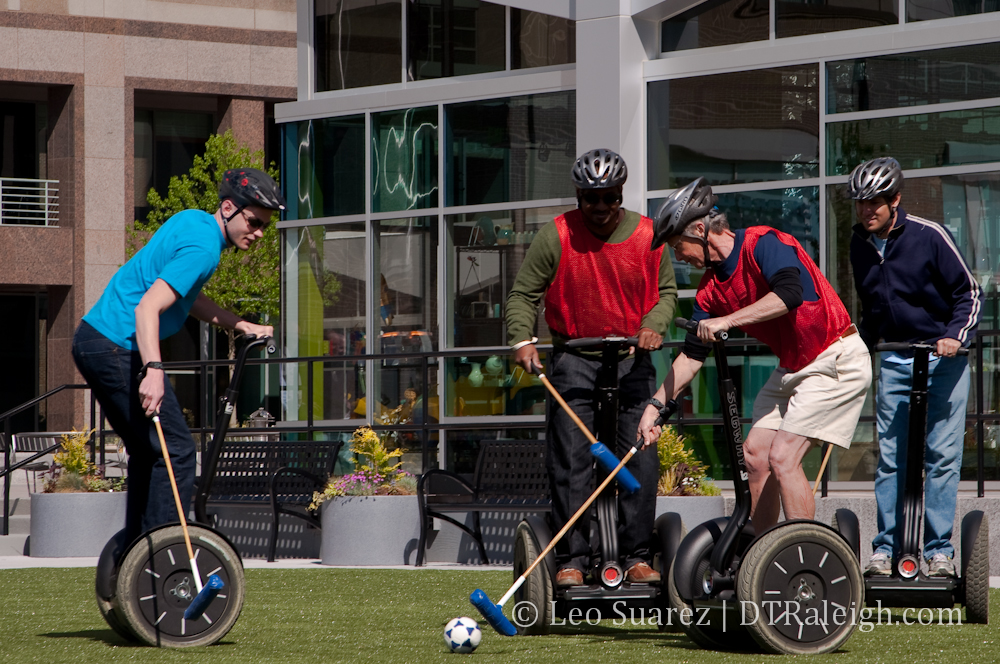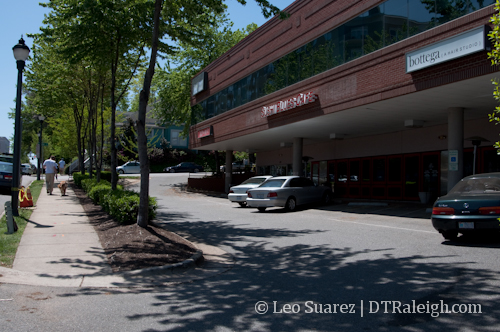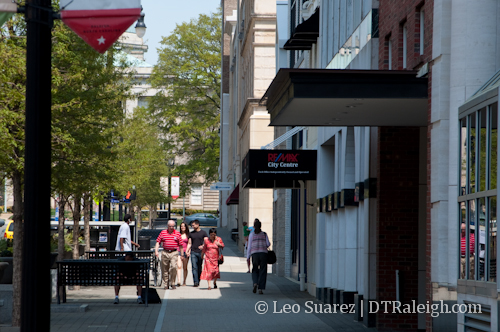
An intense game of segway polo was underway at City Plaza on April 10th, 2010. The games are arranged by Triangle Segway.

An intense game of segway polo was underway at City Plaza on April 10th, 2010. The games are arranged by Triangle Segway.

I’m not reporting any plans for outdoor seating currently but just bringing up plans that never came to be. Outdoor seating is probably a subject that I could talk about for hours and there are some great opportunities for more in downtown Raleigh.
On a gorgeous day this weekend, I walked up Glenwood South and was reminded of old plans that never came to be. Some of you may remember the news of the parking spaces in front of the building with Sushi Blues and Zely & Ritz that were to become outdoor seating areas. It has been almost two years now and if you look at the picture above, I think we can say that those plans were ditched.
All I heard is that the building’s fire code would not allow them to create the outdoor restaurant space without a hefty renovation. I have not verified this with anyone so take it with a grain of salt. But going with it, it is obvious that the building was never designed with intentions of outdoor seating in mind so it’s a shame we missed this opportunity. I’m all for less parking spaces and more people spaces.
The optimist in me says that one day it could happen. If this property, being on a prime location in Glenwood South, continues to be filled with people and lots of foot traffic then the owners are going to see those empty cars taking up space as a complete waste.
This is just one example where the city can act in favor of the comprehensive plan and do away with the parking requirements for a business in downtown. It was most likely, at one point, the city code that drove the kind of front door parking that is here now If owners in this building decide to do away with the spaces then the city should help make it happen.
The Wake County Justice Center expansion site is buzzing with construction activity. The base of the future three tower cranes can be seen in this picture. Click for a larger view.
Building this thing and hoping that the economy turns around for additional sales tax revenue doesn’t sound like a great idea. The additional tax would be dropped however.
Outside consultants – architects, public safety experts or others – could help sort through the divide on the deadlocked, eight-member council and help bring forward some type of consensus, Raleigh Mayor Charles Meeker said.
via Lightner impasse may get a nudge – Wake County – NewsObserver.com. [update: broken link]
Green Square blooms into view at the corner of Dawson and Jones Street.
I finally made it through the Downtown Raleigh Alliance’s analysis and strategy report on retail, read the whole thing here, and there are lots of topics to go over. I thought their recommendations on signage was something I hadn’t thought of since I can’t view downtown through a first-time visitors’ eyes. The report suggests:
If the Downtown core is to become a truly alluring and exciting visitor destination, one that, for example, beckons conventioneers to head northward on Fayetteville Street, the City Council will need to be willing to accept bolder, more dynamic signage appropriate to this goal, as recommend in the Comprehensive Plan. Indeed, this will be critical to the fate of Fayetteville Street as a retail location, which rests partly on its ability to lure conference attendees and daytime workers from its southern end.
The report mentions that the 100 block of Fayetteville Streeet is not as active as the higher ones and that signs could attract visitors from the convention center and hotels down towards it. I always thought the grand capitol building standing right at the end in plain sight was reason enough for people to walk all the way down but maybe not. On a walk yesterday I made a point to look out for the signage along Fayetteville Street to see what our current situation is like.
From a pedestrian view, Fayetteville Street does lack some signage. As you walk down the street, it is a mystery as to what the next shop may be. I think some may still like this approach, it would be like exploring the street to see what it can offer you. However, with signs coming out over the sidewalks, a pedestrian could view many options and possibly make a better decision on where to go.

A pedestrian looking down the street here can’t see much.
It’s kind of like the difference between ordering the buffet or ordering off the menu. At a buffet, most new people look around to see what is available then decide what to eat. A menu shows you everything available easily, then you decide what you want. Signs that can be easily seen by pedestrians can be the “menu” along Fayetteville Street.
But presenting this “menu” is probably the real touchy part of this conversation. They definitely don’t make signs like they used to (see the Mecca picture) and in my opinion, you’ll hear a big outcry against anything that’s too bright and bold. If left unchecked, a busy street would be overwhelmed with large, bright signs competing with each other to get your attention. So we need to reach a balance here. At the bottom of the Downtown Raleigh section of the comprehensive plan are some suggested guidelines for signage: (page 49)
Signage should be compatible in scale, style, and composition with the building or storefront design as a whole.
Diverse graphic solutions are encouraged to help create the sense of uniqueness and discovery found in an urban, mixed-use environment.
All mechanical and electrical mechanisms should be concealed.
Signs should not obscure a building’s important architectural features, particularly in the case of historic buildings.
Signs should be constructed with durable materials and quality manufacturing.
Sign bands above transom and on awnings are preferred signage locations.
Only the business name, street address, building name, and logo should be on an awning or canopy. The lettering should not exceed 40 percent of the awning area.
Illuminated signs should avoid the colors red, yellow, and green when adjacent to a signal controlled vehicular intersection.
Allowed sign types: channel letter signs, silhouette signs (reverse channel), individualized letter signs, projecting signs, canopy/marquee signs, logo signs, awning signs, and interior window signs.
Discouraged sign types: signs constructed of paper, cardboard, styrofoam-typematerials, formed plastic, injected molded plastic, or other such materials that do not provide a sense of permanence or quality; signs attached with suction cups or tape; signs constructed of luminous vacuum-formed plastic letters; signs with smoke-emitting components. Changeable copy signs are prohibited.
I’m sure these guidelines can be interpreted in many ways. Too restrictive? You be the judge.
I believe that word of mouth is still more powerful then an attractive sign that lures someone in but thinking about new visitors to downtown, proper signage is important for Fayetteville Street. New visitors may feel more comfortable knowing about all the options in downtown and it only helps to land repeat visits in the future.
From my inbox to yours.
Raleigh— State Transportation Secretary Gene Conti today announced that two additional trains providing mid-day service between Raleigh and Charlotte will begin on Saturday, June 5, increasing the state-sponsored passenger rail service to six trains operating daily between the state’s two largest cities.
“As our population continues to grow, we must provide people with travel alternatives,” said Conti. “Train travel also provides environmental and energy benefits through reduced congestion and improved air quality.”
Currently, the state sponsors four trains daily, the Piedmont and Carolinian, as North Carolina’s Amtrak. Each train makes a morning and evening run between Raleigh and Charlotte, a trip that is auto competitive at 3 hours and 7 minutes, including intermediate stops at Cary, Durham, Burlington, Greensboro, High Point, Salisbury and Kannapolis.
The new service will add two additional trains in the mid-day giving business travelers, families and college students more options to travel via rail. (See attached schedule.)
The Carolinian also provides daily service to Selma, Wilson, Rocky Mount, to Richmond, Virginia and to the northeast including Washington D.C. and New York City.
Federal Rail Administration Deputy Administrator Karen Rae will address the N.C. Board of Transportation at its meeting Wednesday, March 31 regarding the Obama Administration’s policy on transportation choices as a part of building more livable communities and sustainability.
Rae, Conti and Rail Director Patrick Simmons will be available for media interviews regarding the North Carolina’s new mid-day train service between Raleigh and Charlotte; the $545 million in American Recovery and Reinvestment Act funds awarded to the state in February; and the FRA inspection of NCDOT rail equipment, facilities and capabilities from 2:45 p.m.- 3:15 p.m. via telephone by dialing 1-877-531-0014 and then access room# *8569289* and onsite in room 117 in the Transportation Building at 1 S. Wilmington St. To view the live Board of Transportation Web feed, visit http://wms.its.state.nc.us/dotlive.
The second iteration of Kings will take over a three-story space at 14 West Martin that will combine a 250-capacity music venue with a full-service restaurant and underground bar.
via Kings returns to Raleigh late this summer: Second kingdom: Music: Feature.